The creation myth in Greek Mythology tells the origin of the universe. According to Theogony by Hesiod, there were only voids at the beginning.
Gaia (the Earth) and a few other primary divine beings such as Eros, the Abyss, and the Erebus emerged from these voids.
Gaia then gave birth to Uranus (the Sky) without a male companion. When Uranus fertilized her, the twelve Titans emerged. The group had six males and six females.
Goddess Rhea was one of the six female Titanesses. Later, she became the queen of Titans along with her brother-husband Cronus.
How did she become the queen, and how did she marry her brother? Let’s dig into her life with the top ten facts about her.
Why didn’t the five children die when Cronus swallowed them?
Content
Cronus only swallowed the children. He didn’t eat them, so they were imprisoned inside his stomach. They couldn’t die because the prophecy from Uranus had to be true. If they passed away, Cronus wouldn’t step down from his throne.
Why did Zeus send baby Dionysus to Rhea?
Dionysus was the son of Semele, a lover of Zeus. Hera was famous for torturing the illegitimate children of Zeus. So, Zeus sent Dionysus to Rhea for upbringing. Later, Rhea also provided Dionysus with Amethyst to control his drinking wine when he was grown up.
Did Zeus sleep with Rhea?
According to some ancient sources, Rhea prevented Zeus from marrying because of his penchant. He, in outrage, threatened her to rape her. Then she transformed into a serpent, and Zeus also did the same and raped her in disguise.
What happened when Uranus got castrated?
After Uranus got castrated, the Sky didn’t come to cover the Earth at night but held its place. It was done so that Uranus couldn’t beget new children and make an army for the war against Titans.
Was Rhea immortal?
Egyptians believed that Rhea was the daughter of heaven(Onarus) and Earth (Ge). And they called her Pandora, suggesting that she was an immortal and the first mortal woman.
10. Rhea was the mother of the gods
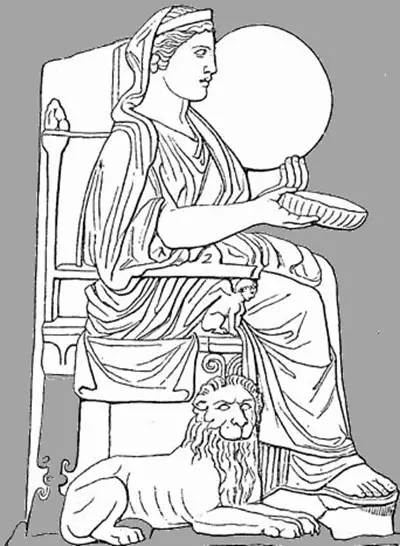
Source: Wikimedia Common
When Cronus and Rhea mated, Rhea bore six children. She had three sons and three daughters. The group included Poseidon, Hades, Demeter, Hestia, Hera, and Zeus, who later became the Twelve Olympians.
Hestia was the eldest among her siblings by birth, whereas Zeus was the youngest. She was the Goddess of the home, hearth, domesticity, virginity, family, and the state.
Whatever was cooked or sacrificed in the household or public place was first given to her.
Poseidon was the God of the sea, ocean, storms, earthquakes, horses. He would protect seafarers and many Hellenic cities and colonies.
But when he was angry, he struck the ground with his trident that caused earthquakes, drownings, and shipwrecks.
Hades was the king of the Underworld, God of the dead and riches. His duty was to receive the departed souls of mortals and immortals in his kingdom.
Demeter was the Greek Goddess of agriculture, harvest, fertility, and sacred law. She would save the fertility of the Earth for agriculture and provide people with grains for bread.
Hera was the queen of the Gods, along with Zeus. She was also the Goddess of marriage, women, childbirth, and family. Though she was the patroness of married women, sometimes, she misused her power.
Zeus was the youngest of all but all-powerful. He was the king of the Gods and God of the Sky, lightning, thunder, law, order, and justice. He had the power to control all gods and the universe.
Rhea’s children were primary Olympian Gods who were born out of Titans. So, she was called the mother of the gods.
9. One of Saturn’s satellites has been named after Rea

Source: Wikimedia Common
Rhea, the second-largest moon of Saturn, was discovered in 1672. Italian astronomer Giovanni Domenico Cassini found it and named it after Greek Goddess Rhea.
He also found three other moons and named them Tethys, Dione, and Iapetus. He also referred to space bodies to King Louis XIV and Titan as Saturn I through Saturn V.
Rhea is also the ninth-largest moon and the second smallest body in the Solar System. It is an airless and icy satellite of Saturn. Similarly, a bird has been named after Rhea. It is a large ratite found in South America that is flightless and without a keel on its legs.
8. Rhea was the Goddess of female fertility, motherhood, and generation
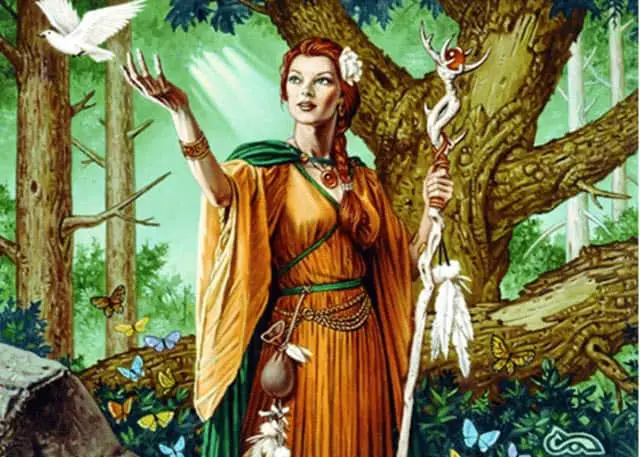
Titan goddess Rhea proved her fertility by bearing six children of the most powerful gods and goddesses. Greek people worshipped her as the Goddess of fertility and motherhood,, forbearing and taking care of them.
Like her name suggests ( ease and flow ), her body connects to the flow of time and menstrual blood, birth waters, time, and milk. The flow of menstrual blood and birth water represented fertility.
And the flow of time refers to the passage of time or generation. Rhea as the wife of Cronus and mother of Olympians, passed Titan and Olympian age. So, she was called the Greek Goddess of generation.
People also worshipped her as the Goddess of comfort and ease. Her name was uttered in blessing, “the gods who live at their Rhea (ease).”
7. Rhea plotted against her husband
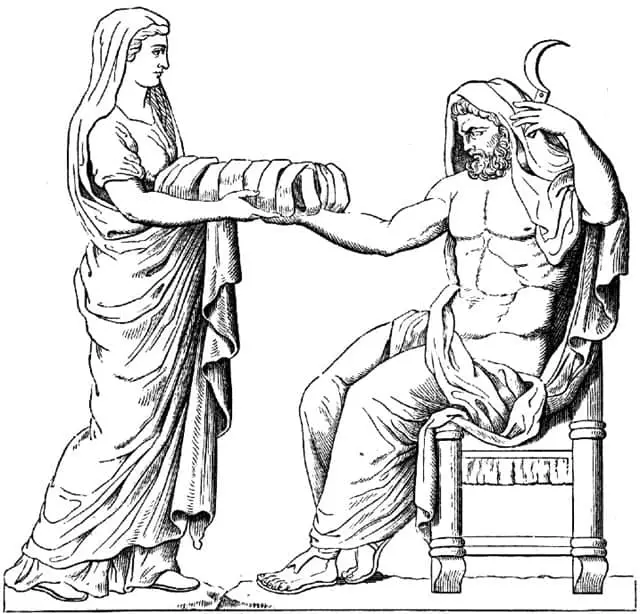
Cronus’s father, Uranus, predicted that his children would overthrow Cronus. Fearing this prophecy, Cronus started swallowing all his children one after another.
He swallowed all his first-born five children. Mother Rhea feared that if she couldn’t save her last child, she would be childless. The youngest and last-born child was Zeus.
To save him from Cronus, the Goddess consulted her mother, Gaia. Gaia taught her a trick. When Cronus asked for the last born baby, she handed him a stone wrapped in cloth like a baby.
Cronus thought that he had swallowed all his children and became relaxed about the prophecy. But the Goddess Rhea secretly took Zeus to Crete.
To reach Crete, she took help from her attendants, the warrior-like Kouretes and Dactyls. They acted as a bodyguard for the infant Zeus. She assigned some nymphs, including Amalthea, to take care of him at Crete.
She returned to Cronus after leaving her son at Crete. Zeus was brought up in the Dictean Cave on Mount Ida.
At the return of Zeus back to Rhea, she took the help of Metis and tricked Cronus into drinking a poisonous drink. He drank,, and it led to him emitting everything that was on his stomach.
Every child he had swollen began coming out one by one. Hestia was the last child to come out of Cronus’s stomach. Zeus, along with all other siblings, planned on overthrowing Cronus and name it the Titanomachy.
6. Rhea is accompanied by a pair of lions that pull a celestial chariot in a statue
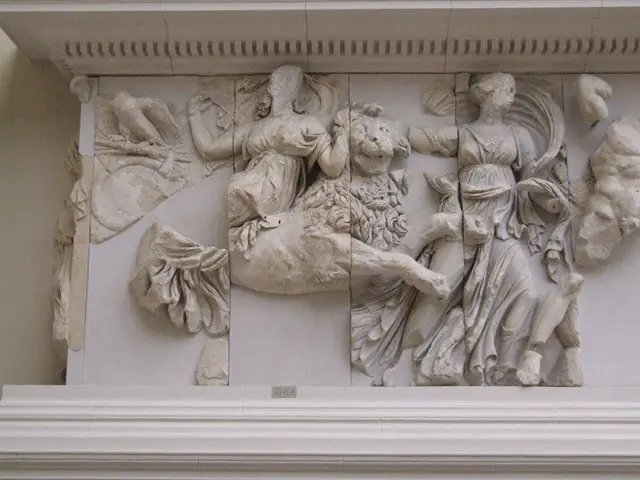
Source: Wikimedia Common
Rhea is closely identified with Cybele, the Phrygian Great Mother. Both goddesses are usually depicted as matronly women, wearing a turret crown, either a Mural crown or a Polos.
They are shown individually as a goddess riding a lion and a chariot drawn by two lions. And sometimes, they are depicted sitting on a throne flanked by lions.
These two lions accompany Rhea because they are her sacred animals. Her other holy attributes are Chariot, tambourine, crown, and cornucopia.
In the fourth century BC, her famous famous symbol of sitting on a celestial chariot driven by a pair of lions. People placed her logo on city gates in Greece.
Two stone lions guarding the gates at the city of Mycenae were the best example of her logo.
Greek statues also featured Rhea holding a stone wrapped in a cloth given to Cronus.
5. Rhea’s Roman equivalent is Ops
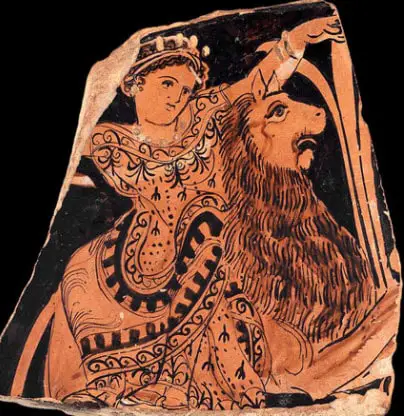
Rhea was worshipped as Ops in Roman Mythology. Ops was the Goddess of Earth and fertility of Sabine origin. She was the daughter of Caelus and Terra.
Her consort was Saturn, from whom she bore Jupiter, Neptune, Pluto, Juno, Ceres, and Vesta. She sits down, holding a wand, or a corn spray and cornucopia in a statue or coin.
Romans held the festival, Opiconsivia, in her honor, where she was worshipped and celebrated by them. She was associated as the goddess of agriculture and wealth, so the festival symbolized the end of the harvest.
She performed her duty exactly like Rhea, bearing the six children, saving the youngest, and helping him seize power. Her sacred symbols were lions, tambourines, crowns, grains, and cornucopia.
4. Lakedaimon, the temple of Rhea in Akriai, was her oldest sanctuary
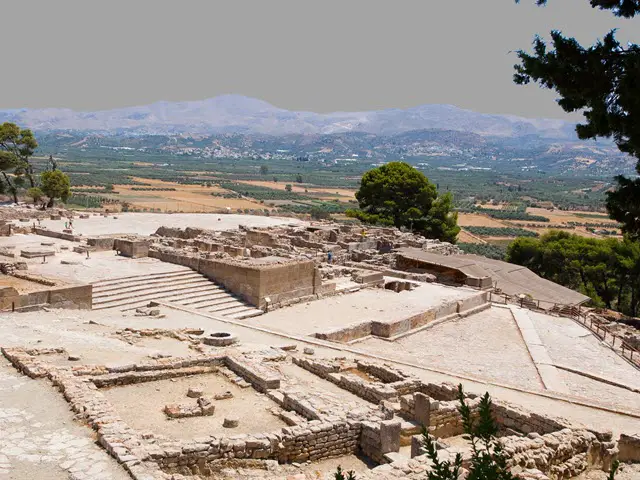
The Greeks honored Goddess Rhea and had built numerous cults and temple dedicated to her. The first temple to be dedicated was at Phaistos where she had left young Zeus hidden from Cronus.
The temple, shaped like a cave, is still known by her name. People living around that temple worshipped and respected her with full heart. They would often dance jubilantly with boisterous drum beats to honor her.
Similiary, there were other temples around Anagyros in Attika and Megalopolis in Arkadia. There, she was worshipped as the mother f gods or “Meter Theon.”
However, the famous and most visited temple has to be Lakedaimon located in Peloponessos. The people of Akriai built this temple in her honor and it is listed as one of the oldest santuary of Goddess Rhea.
3. Rhea was imprisoned by her father
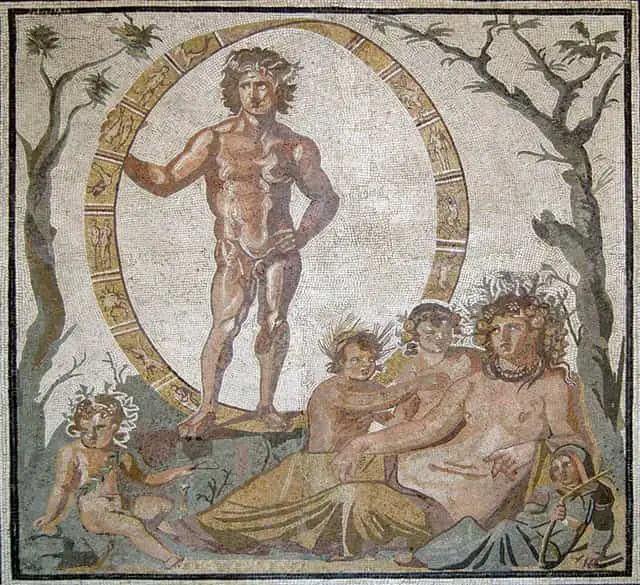
Source: Wikimedia Common
Rhea gave birth to the three one-hundred-handed giants called the Hekatonkheires, and the Cyclopes, the one-eyed giants. They were famous giants of Greek Mythology.
When Uranus feared that his children would overthrow him from power, he started imprisoning his children one after another, including Rhea. He also didn’t spare the newly born Hekatonkheires and Cyclopes.
Gaia was angry after her husband’s act, so she created a plot against him. She asked her children to castrate Uranus, but nobody was ready for the job.
Cronus decided to do it, he took help of his brothers, castrated, and threw his testicles into the sea. Then, he became the king of Titans and married his sister, Rhea.
2. Rhea was often pregnant but never indeed a mother
According to Ovid’s Fasti, Rhea was angry after Cronus swallowed all her children except Zeus. She couldn’t enjoy her motherhood even when her youngest child was alive.
She nursed even the lions to fill her desire for motherhood, and the lions later became her sacred companions. She often cried over the absence of her children.
She met Zeus only when he was grown up. Also, when all five children were reborn from the mouth of Cronus, they went to the war, the Titanomachy.
It took a decade to end the war. When Rhea finally met her children, they were all grown up and assigned duty by Zeus. This way, Rhea was deprived of being truly a mother.
Her desire to be a mother also can be seen in the myth when she nurtured young Dionysus. Hermes had brought Dionysus to her on the order of Zeus to avoid Hera’s rage.
Ancient sources also claim that she was present at the birth of Apollo. She, with her sisters Tethys and Theia, washed Apollo with pure and clean water. And they placed him in a white garment.
They looked after him until Leto recovered.
1. Rhea had also participated in the Gigantomachy
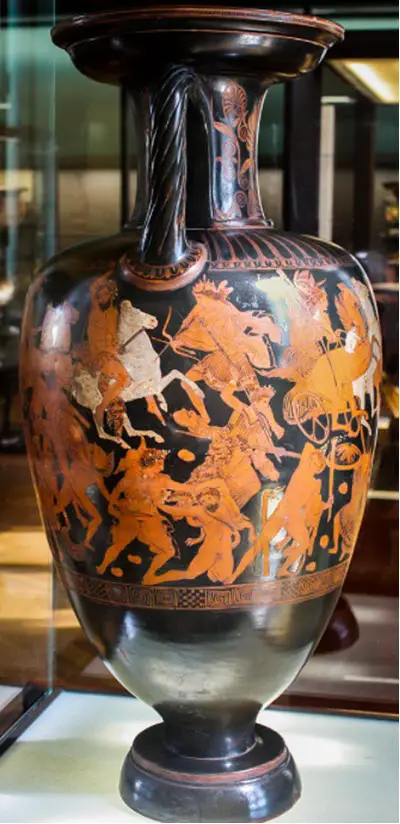
Gigantomachy was a battle between the Giants or Gigantes, sons of Uranus and Gaia, and the Olympian gods.
They all wanted to overthrow the old reign and establish themselves as the new rulers of the universe.
The battle started when the Giant Alcyoneus stole the cattle of god Helios. There was a prophecy that gods could win over the giants only when a mortal supported them.
So, Gaia tried to find the plant to shield the giants. But Zeus took every plant for himself, not leaving even a single one.
During the battle, Heracles fought Alcyoneus, who didn’t die in his homeland. On Athena’s advice, Heracles dragged the giant out of his land and killed him.
Similarly, Dionysus killed Eurytus, and Hermes killed Hippolytus. The war ended when Python and his brother Enceladus were imprisoned.
Rhea participated in the battle and helped Olympians to defeat the giants. But the account is unknown of how she performed her duty during the war.
Conclusion
The primordial gods and Titan gods met a similar end. Children of both parties dissolved their fathers’ reign, which is itself an interesting fact.
But what interests me is that the plant, space bodies, birds, and animals have their names after Greek deities. Take Rhea, for an example.
Which fact do you find most interesting from the above reading? Let your thoughts pass in the comment section.
